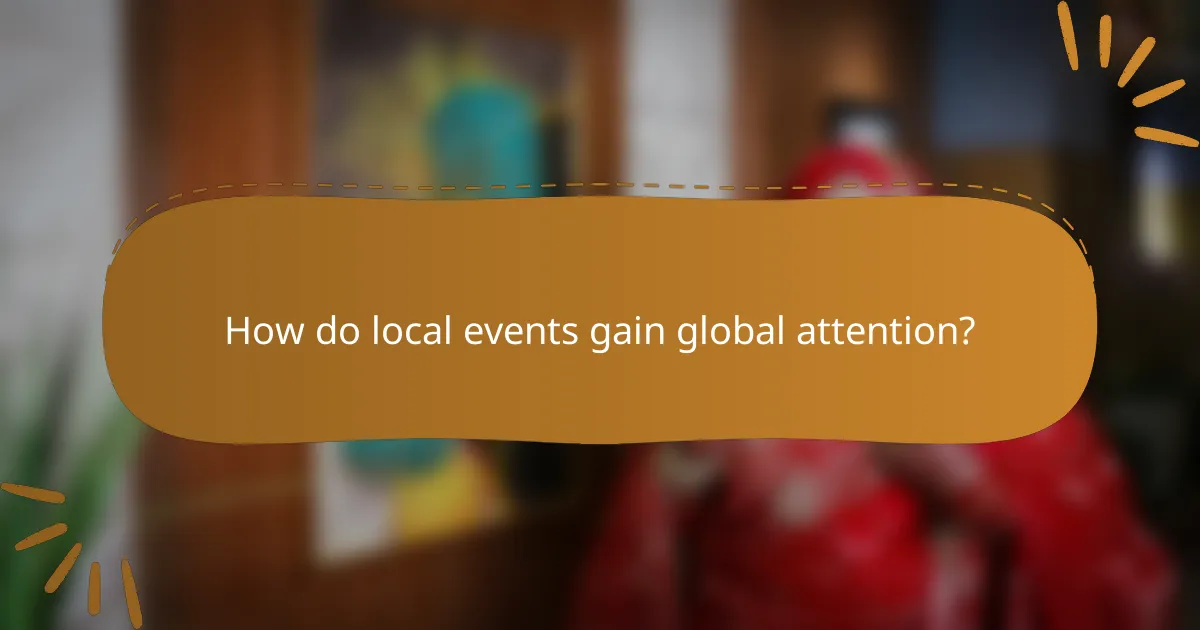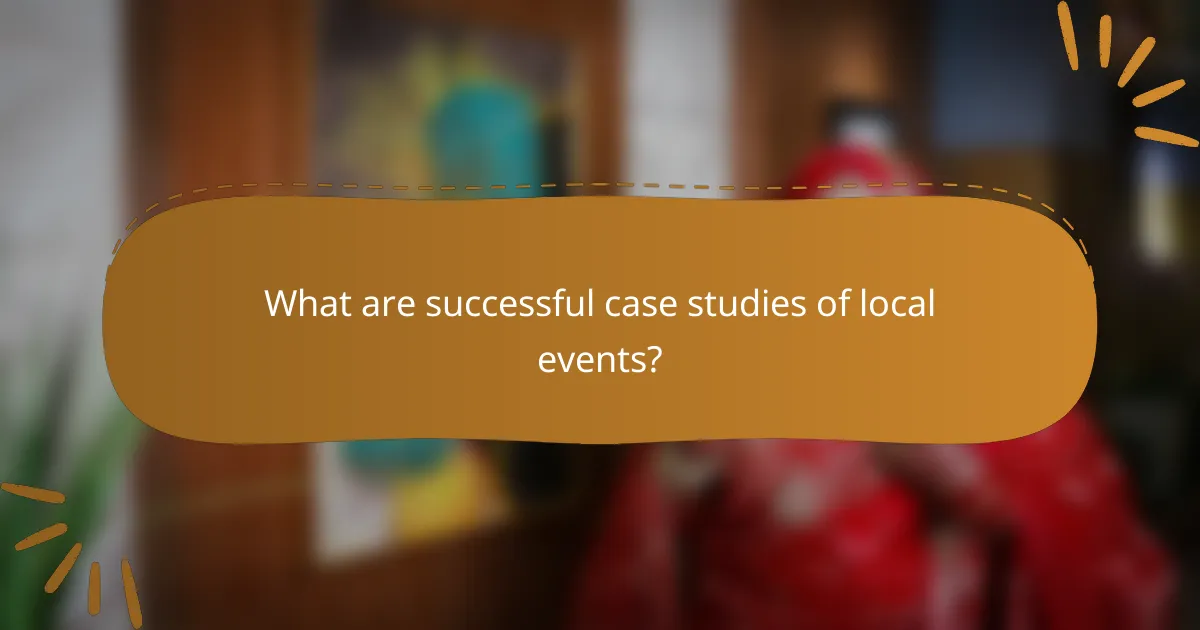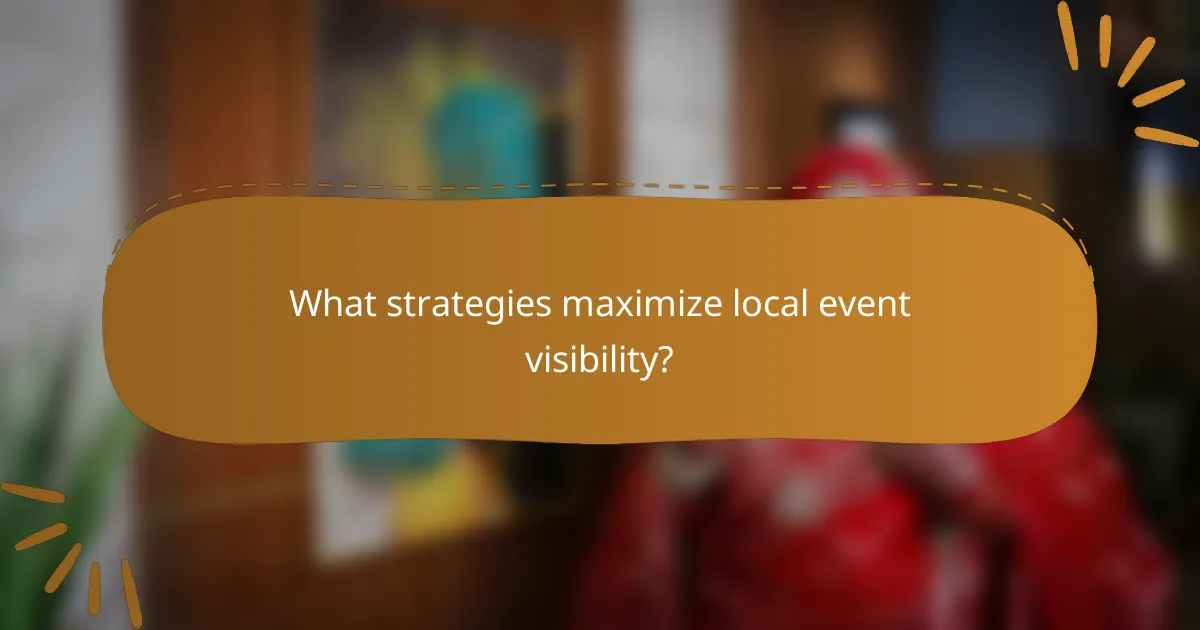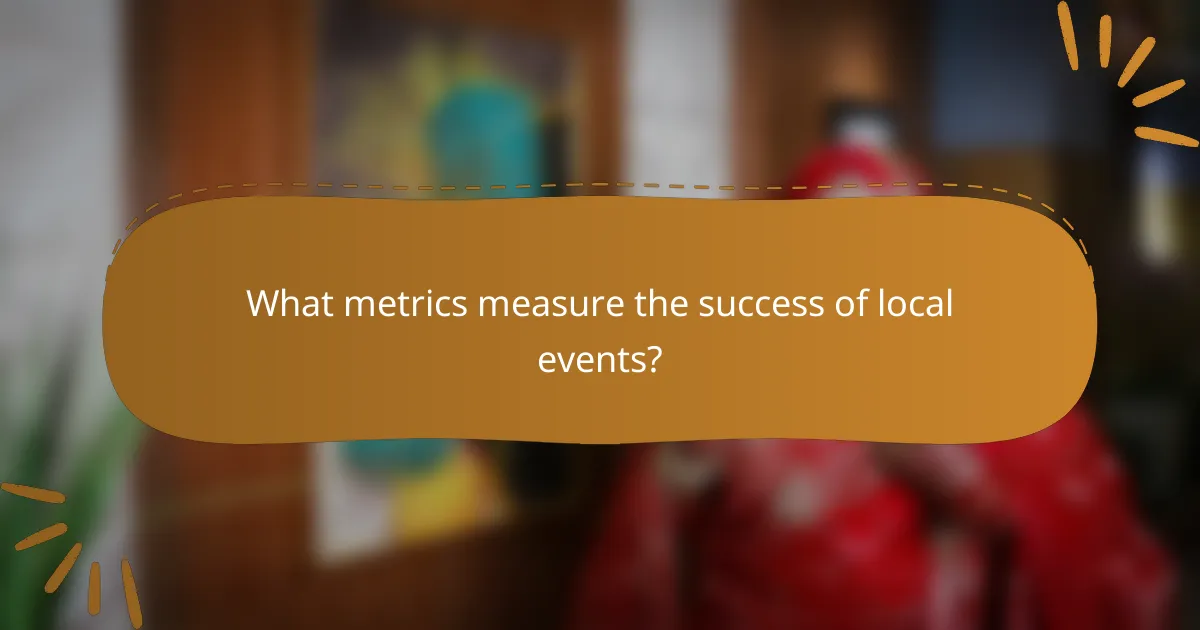Local events have the potential to capture global attention by effectively utilizing digital platforms, influencer partnerships, and engaging storytelling. Through strategic marketing and community involvement, these events not only highlight unique cultural aspects but also stimulate economic growth and broaden their reach beyond local boundaries.

How do local events gain global attention?
Local events gain global attention through strategic use of digital platforms, influencer collaborations, and compelling narratives. By leveraging social media and media coverage, these events can reach audiences far beyond their immediate geographic boundaries.
Social media amplification
Social media plays a crucial role in amplifying local events to a global audience. Platforms like Twitter, Instagram, and Facebook allow event organizers to share real-time updates, engage with participants, and encourage user-generated content. This creates a ripple effect, as attendees share their experiences, further expanding the event’s reach.
To maximize impact, use relevant hashtags and encourage attendees to tag the event in their posts. This can significantly increase visibility and engagement, drawing in viewers who may not have been aware of the event initially.
Influencer partnerships
Collaborating with influencers can elevate a local event’s profile on a global scale. Influencers often have dedicated followings that trust their recommendations, making them effective ambassadors for the event. By partnering with influencers who align with the event’s theme, organizers can tap into new audiences.
Consider offering influencers exclusive access or unique experiences at the event to encourage authentic content creation. This not only boosts visibility but also enhances the event’s credibility through trusted voices.
Live streaming platforms
Live streaming platforms like YouTube, Facebook Live, and Twitch allow local events to reach a worldwide audience in real-time. By broadcasting key moments, organizers can engage viewers who are unable to attend in person. This approach can significantly increase the event’s visibility and participation.
Ensure high-quality production and interactive elements, such as live Q&A sessions, to keep the online audience engaged. Promoting the live stream ahead of time can also help attract viewers from different time zones.
Global media coverage
Securing coverage from global media outlets can dramatically increase a local event’s visibility. Journalists are often looking for unique stories, so highlighting what makes the event special can attract their attention. Press releases and media invitations can help facilitate this process.
Building relationships with journalists and providing them with compelling angles or exclusive insights can lead to more extensive coverage. Consider inviting media representatives to experience the event firsthand, which can result in more authentic and engaging stories.
Engaging storytelling
Crafting a compelling narrative around a local event is essential for capturing global interest. Storytelling can highlight the event’s significance, cultural relevance, and the experiences of participants. This narrative can be shared across various platforms to create a cohesive message.
Utilize multimedia elements, such as videos and testimonials, to enhance the storytelling experience. Engaging narratives not only attract attention but also foster emotional connections with audiences, encouraging them to share the event with others.

What are successful case studies of local events?
Successful case studies of local events demonstrate how community-driven initiatives can attract global attention and foster economic growth. These events often showcase unique cultural elements, engage local businesses, and create memorable experiences for attendees.
Rio Carnival
The Rio Carnival is one of the largest and most famous festivals in the world, attracting millions of visitors each year. It features vibrant parades, samba music, and elaborate costumes, showcasing Brazil’s rich cultural heritage. Local businesses thrive during this period, with significant boosts in tourism-related revenue.
To successfully organize a carnival, consider engaging local samba schools and artists, ensuring a diverse representation of the community. Additionally, effective marketing strategies, both online and offline, can enhance visibility and draw international tourists.
Oktoberfest
Oktoberfest in Munich, Germany, is the world’s largest beer festival, drawing millions of attendees annually. This event celebrates Bavarian culture with traditional food, music, and, of course, a wide variety of beers. Local breweries and restaurants benefit immensely from the influx of visitors.
For a successful Oktoberfest, focus on creating an authentic atmosphere with local vendors and entertainment. It’s crucial to manage logistics, such as crowd control and safety measures, to ensure a positive experience for all participants.
Burning Man
Burning Man is an annual event held in the Nevada desert that emphasizes community, art, and self-expression. Participants create temporary art installations and engage in various activities, fostering a unique culture of collaboration and creativity. The event’s principles encourage sustainability and inclusivity.
To replicate the essence of Burning Man, prioritize community involvement and artistic expression. Establish clear guidelines for participation and encourage attendees to contribute to the event’s atmosphere. This approach can help create a memorable experience that resonates with participants long after the event concludes.
Coachella
Coachella is a renowned music and arts festival held in California, attracting a diverse audience from around the globe. It features a wide range of musical genres and art installations, making it a cultural hotspot. Local businesses benefit from increased tourism and sales during the festival period.
To ensure a successful festival like Coachella, invest in a strong lineup of artists and effective marketing strategies. Collaborate with local vendors to enhance the festival experience, and consider sustainability practices to minimize environmental impact. This combination can lead to a thriving event that captivates attendees and generates economic benefits for the community.

What strategies maximize local event visibility?
Maximizing local event visibility involves a combination of targeted advertising, SEO optimization, and partnerships with local businesses. These strategies help reach a broader audience and enhance engagement, ensuring that the event garners the attention it deserves.
Targeted advertising
Targeted advertising focuses on reaching specific demographics that are most likely to attend the event. Utilizing platforms like Facebook and Google Ads allows event organizers to define their audience based on interests, location, and behaviors, which can significantly increase attendance.
Consider setting a budget that aligns with your goals; even a few hundred dollars can yield substantial visibility in local markets. Monitor ad performance regularly to adjust targeting and maximize return on investment.
SEO optimization
SEO optimization enhances the online visibility of your event by improving its ranking on search engines. Use relevant keywords in your event description, title, and metadata to attract organic traffic. Local keywords, such as the city name or venue, are particularly effective.
Ensure that your event page is mobile-friendly and loads quickly, as these factors impact search rankings. Regularly updating content and acquiring backlinks from local websites can further boost your visibility.
Partnerships with local businesses
Forming partnerships with local businesses can amplify your event’s reach. Collaborate with nearby restaurants, shops, or service providers to cross-promote each other’s offerings, creating a win-win situation.
Consider offering joint promotions or discounts for attendees who visit partner businesses. This not only increases visibility but also fosters community support, making your event more appealing to potential attendees.

How do demographics influence event marketing?
Demographics play a crucial role in event marketing by shaping the target audience’s preferences, behaviors, and engagement strategies. Understanding age, location, and cultural background helps marketers tailor their campaigns effectively to maximize attendance and participation.
Age group targeting
Age group targeting involves customizing marketing strategies to resonate with specific age demographics. For example, events aimed at younger audiences may utilize social media platforms like TikTok and Instagram, while those targeting older individuals might focus on Facebook or email marketing.
Consider the interests and lifestyles of different age groups. Millennials and Gen Z may prefer interactive experiences and digital engagement, while Baby Boomers might value more traditional formats and in-person interactions. Tailoring content to these preferences can significantly enhance engagement.
Geographic preferences
Geographic preferences refer to the location-based interests and behaviors of potential attendees. Events in urban areas may attract a diverse crowd, while rural events might cater to local communities with specific cultural ties. Understanding these dynamics can guide marketing strategies.
For instance, a music festival in a metropolitan area may promote a lineup of popular artists, while a local fair might emphasize regional food and crafts. Marketers should consider local customs and interests to create relevant promotional material that resonates with the target audience.
Cultural relevance
Cultural relevance is about aligning event marketing with the values, traditions, and interests of the target demographic. Events that reflect cultural significance can foster a deeper connection with attendees, enhancing participation and loyalty.
For example, a festival celebrating a local heritage or cultural event can attract participants who identify with that background. Marketers should research cultural trends and incorporate them into their messaging and programming to ensure that the event feels authentic and engaging.

What metrics measure the success of local events?
Success for local events can be gauged through several key metrics, including attendance numbers, social media engagement, and revenue generated. These indicators provide insights into the event’s reach, popularity, and financial viability.
Attendance numbers
Attendance numbers are a primary metric for assessing the success of local events. Higher attendance typically indicates greater interest and can lead to increased community engagement. For example, a local festival attracting hundreds to thousands of attendees can signify a successful outreach effort.
When evaluating attendance, consider the venue capacity and the expected turnout based on previous events. A good rule of thumb is to aim for at least 70-80% of the venue’s capacity to ensure a vibrant atmosphere.
Social media engagement
Social media engagement reflects how well the event resonates with the audience online. Metrics such as likes, shares, comments, and hashtag usage can provide valuable insights into public perception and reach. For instance, a local concert that generates significant buzz on platforms like Instagram or Facebook can enhance its visibility and attract future attendees.
To effectively measure engagement, track interactions before, during, and after the event. Aim for a consistent increase in followers and engagement rates, ideally targeting a growth of 10-20% in social media interactions compared to previous events.
Revenue generated
Revenue generated is a crucial metric that indicates the financial success of local events. This includes ticket sales, sponsorships, merchandise, and concessions. A well-planned event should aim to cover its costs and ideally generate a profit, with a target revenue that exceeds expenses by at least 20-30%.
When analyzing revenue, consider the pricing strategy and potential sponsorship opportunities. Offering tiered ticket pricing or early bird discounts can help maximize attendance and revenue. Additionally, tracking expenses closely will ensure that the event remains financially viable.

What are the challenges in promoting local events?
Promoting local events involves several challenges, including limited budgets, competition for attention, and the need to effectively reach target audiences. Event organizers must navigate these hurdles to ensure successful turnout and engagement.
Budget Constraints
Many local events operate on tight budgets, which can limit marketing options. Organizers often rely on low-cost strategies such as social media promotion, community partnerships, and grassroots outreach to maximize their reach without overspending.
To make the most of a limited budget, consider prioritizing high-impact channels. For instance, using local influencers or community groups can yield better results than broader advertising methods. Allocating funds for targeted online ads can also be effective, especially when focusing on specific demographics.
Competition for Attention
Local events frequently compete with numerous other activities, making it essential to stand out. This competition can come from other events, entertainment options, or even everyday distractions that vie for potential attendees’ attention.
To differentiate your event, create a compelling narrative around it. Highlight unique features, such as special guests or interactive activities, and utilize eye-catching visuals in promotional materials. Engaging storytelling can draw interest and encourage attendance.
Target Audience Engagement
Identifying and engaging the right target audience is crucial for the success of local events. Understanding who is most likely to attend helps tailor marketing efforts and ensures that messaging resonates with potential participants.
Utilize surveys or social media polls to gather insights about community interests and preferences. This data can guide promotional strategies, ensuring that messaging aligns with audience expectations. Additionally, consider offering early-bird tickets or group discounts to incentivize attendance.
